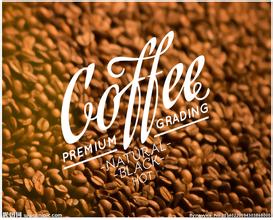Introduction of grinding scale for description of taste and flavor of aricha coffee bean varieties
Introduction to the varieties of grinding scale for the description of the characteristics, taste and flavor of Yega Xuefei aricha coffee
The Aretha treatment station on the east side of the town of Yejassefi chose the sun treatment to treat the raw beans, without first removing the peel and pulp of the fruit, nor removing the mucus layer through the fermentation step, but spreading it directly on the scaffolding after hand selection, and the fruit gradually changed from bright red to dark brown within two weeks before it could be stored. Then a sheller was used to remove the peel, pulp and endocarp adhered to the seeds at one time. Finally, the immature beans with bright green seed coat and the over-fermented overripe beans were selected to greatly improve the baking consistency and cup test quality. Yirgacheffe Aricha Grade 1 raw beans are yellow and green in color, which is a typical sun-cured coffee with uniform and full grains and few defective beans. Ordinary gunny bags are used for export. Basic information of coffee printed and dyed on the sack (processing plant, exporter, ICO code, processing method, producing area) inside the sack is a plastic bag packed with agricultural products, this coffee is roasted in a light and slow way, which best reflects its characteristics Africa is the hometown of coffee. Coffee trees are likely to be found in Ethiopia's KAFFA province. Later, batches of slaves were sold from Africa to Yemen and the Arabian Peninsula, and coffee was taken everywhere along the way. To be sure, Yemen started growing coffee in the 15th century or earlier. Although Arabia had the busiest port city in the world at that time, it banned the export of any seeds. This barrier was finally broken through by the Dutch, and in 1616, they finally smuggled the surviving coffee trees and seeds to the Netherlands and began to cultivate Yega Xuefei in the greenhouse using the oldest sun treatment, but in 1972, Ethiopia introduced the washing technology of Central and South America to improve its quality, which made the jasmine and citrus fragrance of Yega Xuefei clearer and more refined, and became one of the best beans in the world. The superb washing technology plays an important role. After the 1970s, this area is mainly washed, and it has become the most popular water-washed bean producing area in Egypt. Sun Yega Chuefei sets a strict standard for collecting red fruits (as a result of coffee trees). Unripe green fruits or defective fruits are removed manually before exposure to coffee fruits, and damaged or moldy fruits are removed during the sun drying process. after two weeks, the flesh sugar and essence seep into the coffee beans, the water content is reduced to 12%, and then scrape the hardened pulp, pectin layer and pods with a planer. Take out the coffee beans and test the density and color of the beans. After eliminating the defective beans, the workers finally picked out the defective beans with the naked eye and screened them layer by layer, resulting in the cleanliness and vulgarity of Yejiaxuefei sun-dried beans and a strong attractive fruit aroma.

Important Notice :
前街咖啡 FrontStreet Coffee has moved to new addredd:
FrontStreet Coffee Address: 315,Donghua East Road,GuangZhou
Tel:020 38364473
- Prev

Flavor description of Colombian Rosa coffee beans taste varieties treated by grinding scale
Flavor description of Colombian Rose Summer Coffee beans the suitable climate in Colombia provides a real natural pasture for coffee. Coffee trees in Colombia are mainly cultivated in the Andes, on steep slopes about 1300 meters above sea level, where the annual temperature is about 18 degrees Celsius, annual rainfall is 2000 to 3000 millimeters, and latitude 1-11.
- Next

The production method of Starbucks caramel macchiato Flavor description Grinding scale of Coffee
Starbucks Caramel macchiato production method Coffee Flavor description Grinding scale Caramel macchiato to sum up, in fact, it is to add espresso and vanilla to the strong hot milk, and finally sprinkle the surface with pure caramel to make a favorite shape. there are three different flavors in this cup of caramel macchiato, from which we can know the taste of caramel macchiato.
Related
- Detailed explanation of Jadeite planting Land in Panamanian Jadeite Manor introduction to the grading system of Jadeite competitive bidding, Red bid, Green bid and Rose Summer
- Story of Coffee planting in Brenka region of Costa Rica Stonehenge Manor anaerobic heavy honey treatment of flavor mouth
- What's on the barrel of Blue Mountain Coffee beans?
- Can American coffee also pull flowers? How to use hot American style to pull out a good-looking pattern?
- Can you make a cold extract with coffee beans? What is the right proportion for cold-extracted coffee formula?
- Indonesian PWN Gold Mandrine Coffee Origin Features Flavor How to Chong? Mandolin coffee is American.
- A brief introduction to the flavor characteristics of Brazilian yellow bourbon coffee beans
- What is the effect of different water quality on the flavor of cold-extracted coffee? What kind of water is best for brewing coffee?
- Why do you think of Rose Summer whenever you mention Panamanian coffee?
- Introduction to the characteristics of authentic blue mountain coffee bean producing areas? What is the CIB Coffee Authority in Jamaica?

